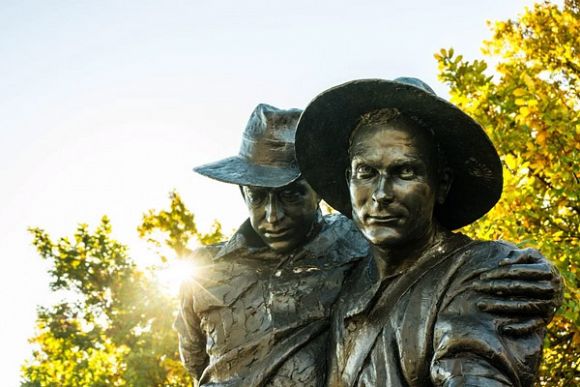It is now eight years since Peter FitzSimons first published Gallipoli. The question is, does it still stand up?
The acronym ANZAC (Australian and New Zealand Army Corps) is deeply rooted in our history and our future. The future of two new nations – Australia and New Zealand – was blighted by the loss of 10,880 troops at Gallipoli.
The total number of deaths of all combatants was a staggering 130,000 plus. Add the number of men broken in body and spirit by ten and a half months of bloody combat and it could be argued that Gallipoli was one of the worst campaigns in history.
Since the first publication on Gallipoli in 1916, most writers have been either those who served – and survived – or academics who have spent many years researching the disaster.
But in recent years we have had works by two major amateur historians. The first Gallipoli, by Les Carlyon, was published in 2001. Peter FitzSimons followed in 2014 with his Gallipoli.
Carlyon’s book has a wider view of the campaign. He deals with aspects such as the large British contingent and the French troops. He also discusses diplomatic relations between the Turkish Government and the Germans, and he is good at grasping the politics of the time.
FitzSimons puts his focus on the Anzacs. He wants to put us "with" the men who fought the Turkish enemy.
His story starts in Australia with the visit of Lord Kitchener, then moves to the deserts of Egypt where he discusses how our troops were expected to be sent to the battlefields of France. When Sir Winston Churchill got the bright idea of capturing the Dardanelles in the hope of putting pressure on Germany, Australian and New Zealand forces were on hand to do the job along with British, Indian and French troops.
Unlike a professional historian, FitzSimons wants to give today’s readers a feeling that they are there, beside the soldiers in the trenches and gullies. He writes in the present tense as if this is an adventure story. But it is real — it is the day-after-day slaughter of Australians, New Zealanders, British and French and of course, Turkish defenders.
To recreate the scene, FitzSimons uses old typewriter typefaces and cables printed in block letters, such as the cable from Churchill to Admiral de Robeck on 23 March 1915:
‘TO PERSEVERE METHODICALLY BUT
RESOLUTELY WITH THE PLAN CONTAINED IN
YOUR INSTRUCTIONS…’
Not only does this give the impression that you are reading the actual cables, but letters home and to friends are printed in script form.
FitzSimons follows those who questioned the progress of the battles and observes the quality of the generals who ordered men to their death. And he is good at description, telling us of the brotherly love between the Australians and their Turkish enemy. And the deaths of men whose courage makes us, even more than a century after the battle, feel humbled at the bravery on both sides.
However, his descriptive powers sometimes do run away with him. When C.E.W. Bean, the great war diarist and historian goes out to save a wounded man and is ordered to stop, FitzSimons writes: ‘"I must”, his voice filled with Victorian virtue.’ Really?
Mention must be made of the excellent maps by Jane Macaulay. This is one of the best features of this book. Clearly and simply drawn, they help us understand the nature of the terrain in which the battles were fought.
The epilogue is thought-provoking and sensitively written. FitzSimons discusses political and social outcomes and what happened to the men who planned and the man who suffered. The final page brings us to a photograph of a Turk and an Australian embracing in 1990, 75 years after the battle.
For 107 years Anzac soldiers from a new world have lain in the hills alongside those of the armies of Xerxes and Alexander the Great. Perhaps it is now time to leave them in peace.
'Gallipoli' is available from Booktopia for $21.25 (paperback) RRP.
This book was reviewed by an IA Book Club member. If you would like to receive free high-quality books and have your review published on IA, subscribe to Independent Australia for your complimentary IA Book Club membership.
Michael Read is a retired public servant, teacher and academic.
Related Articles
- EDITORIAL EXCERPT: Lest we forget — that war is hell
- EDITORIAL: Lest we forget — that war is hell
- Anzac Day and the war to end all wars
- Gallipolitics: Why no VC for teenage hero Teddy Sheean?
 This work is licensed under a Creative Commons Attribution-NonCommercial-NoDerivs 3.0 Australia License
This work is licensed under a Creative Commons Attribution-NonCommercial-NoDerivs 3.0 Australia License
Support independent journalism Subscribe to IA.












